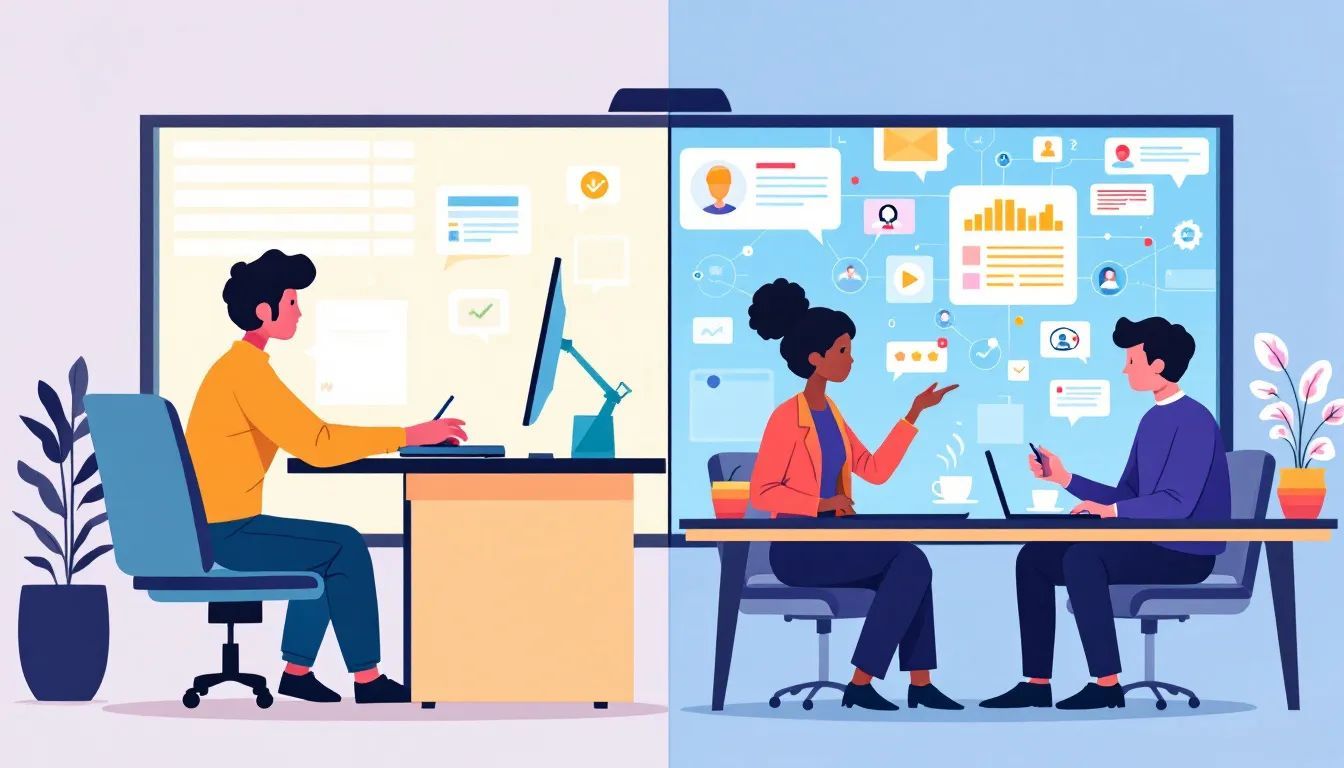Introduction
Remote work has transformed how teams connect, and strategies for Remote Team Building are vital. In today’s digital age, building strong virtual connections is essential for employee satisfaction and overall productivity. For those exploring ways to keep virtual teams engaged, understanding the trend of Remote Team Building early on can spark a journey toward a more cohesive and supportive work environment. In this article, we will explore innovative strategies, practical tips, and creative ideas to enhance team spirit even when physical interaction is rare. You'll discover actionable insights and step‐by‐step approaches that make connecting across distances effortless and fun.
Consider these key factors for effective virtual connection:
- Enhanced communication techniques.
- Innovative ways to build trust.
- Flexibility in activity planning.
Building a positive virtual culture requires both intention and innovation.
Great teamwork can flourish even in a fully remote setting.
Not only do these approaches address employee isolation, but they also lead to improved performance and well‐being. As remote work becomes the norm, early adoption of dedicated team-building activities can prevent burnout and promote creative collaboration. In the following sections, you will learn about the true value of these practices, approaches to overcome common challenges, and how to measure well-being across dispersed teams. Get ready to explore a world where virtual meetings are not just about work updates—they’re also about building authentic human connections.
Additionally, we ensure that every tip provided is practical, relatable, and easy to implement. By following the strategies outlined below, you’ll effortlessly discover techniques that work for your unique team structure.
The Value of Remote Team Building

The modern workplace is evolving and many organizations now recognize the long-term benefits of Remote Team Building. When employees work from different locations, maintaining team morale and active communication often becomes challenging. Nevertheless, organizations that invest in purposeful practices see clear improvements in productivity, mutual trust, and overall job satisfaction.
A strong culture of team support leads to several advantages. First, remote employees often benefit from increased flexibility and autonomy. When combined with structured team-building initiatives, this flexibility drives personal accountability and a sense of belonging. Second, purposeful Remote Team Building opens channels of honest communication, which in turn nurtures creativity and idea-sharing. As colleagues participate in structured virtual activities, they learn more about each other’s strengths and personalities, creating avenues for smoother cross-functional collaboration.
Key Statistics Supporting Remote Team Success
- • 85% of remote employees report enhanced work satisfaction when regular team-building sessions are provided.
- • Employee retention rates improve by almost 30% in teams that engage in dedicated group activities.
- • Virtual collaboration tools increase team productivity by over 25% when combined with engaging culture-building programs.
These numbers emphasize that Remote Team Building is not merely an extra activity—it is a strategic investment in workforce performance. As businesses continue to harness digital solutions, integrating these practices into daily workflows helps preserve a sense of unity across channels. An organized approach to virtual get-togethers underscores the importance of both formal and informal interactions. A growing body of evidence shows that when teams feel connected and valued, innovation and problem solving become second nature.
Data shows that connected teams outperform isolated ones by a significant margin.
Team spirit thrives when every member feels recognized and included.
Overcoming Challenges in a Remote Environment
Working remotely has many benefits, but it also brings several potential pitfalls. Remote employees can experience isolation, miscommunication issues, or difficulties due to varying time zones. It takes an intentional approach for organizations to turn these challenges into opportunities. With the right mindset, Remote Team Building can transform obstacles into strengths and enable teams to overcome barriers while feeling more connected.
When teams are separated by miles, consistently bridging the communication gap becomes a priority. One can often see that informal chats and spontaneous water cooler moments are lost in digital spaces. Addressing these issues requires clear strategies and robust digital collaboration tools. For instance, setting up an ongoing schedule for virtual meetings—and even brisk check-ins—can help colleagues stay connected on a personal level. Creativity becomes essential when finding methods to engage everyone, no matter their location.
Tips for Facilitating Open Interaction
Here is an ordered list of effective practices:
- Schedule short, regular virtual meetups to create routine social interactions.
- Encourage informal breakout sessions so teammates can discuss non-work subjects.
- Rotate meeting hosts to give everyone a chance to share their ideas and lead discussions.
Implementing these suggestions ensures your team feels valued and heard. Additionally, setting clear expectations for communication and providing avenues for feedback reinforce these efforts. By creating safe spaces for sharing, managers can help eradicate feelings of isolation and promote a warmer team atmosphere. Techniques like virtual coffee chats, informal discussion channels, and interactive games are all worthy of consideration. Each acts as a bridge between remote workers and helps foster a more cohesive work environment.
Consistency in virtual meetings paves the way for genuine team bonding.
Overcoming isolation starts with offering multiple touchpoints for interaction.
Creative Remote Team Building Activities
Many organizations have discovered that creative activities can powerfully unite remote teams. The key is to design engaging and straightforward exercises that cater to diverse interests and encourage genuine conversation. Often, simple actions such as a themed show-and-tell or a virtual quiz can transform a dull meeting into a dynamic, memorable experience. Creative Remote Team Building activities offer more than just a break from routine—they inspire collaboration and help employees learn about each other beyond professional titles.
Consider hosting a series of fun virtual challenges that ignite imaginative thinking. For example, organize a “virtual scavenger hunt” where team members search for items in their home offices. You might also set up a trivia game themed around colleagues’ hobbies or recent projects. Such activities not only energize the team but also reinforce the idea that work and play can coexist harmoniously.
Incorporating the Keyword: Remote Team Building in Activity Planning
When planning these events, it is essential to align the activity with your team’s interests. Here is an ordered list to guide your brainstorming process:
- Identify common interests among team members by conducting a short anonymous survey.
- Plan an activity that reflects these interests and resonates with the majority.
- Establish clear goals for the event to ensure it promotes both fun and learning.
Integrating creative methods into your agenda makes virtual interactions more lively and productive. It is also wise to mix scheduled group activities with spontaneous interactions, so everyone remains engaged. In the spirit of innovation, some companies even design hybrid events that combine individual challenges with group accomplishments. The focus remains on ensuring that each exercise contributes to a stronger sense of community across remote workplaces.
Creativity in virtual activities can turn routine meetings into memorable experiences.
Innovation is the catalyst that bridges virtual gaps and forges lasting bonds.
Leveraging Technology and Tools
The digital era offers a treasure trove of platforms and tools designed to enhance collaboration and connectivity. Integrating the right technological solutions makes it easy for teams to remain engaged no matter how far apart they are. A well-chosen tool can be the backbone of virtual interactions, ensuring that every remote meeting feels as dynamic and interactive as possible. By leveraging technology effectively, installations of communication tools and scheduling apps facilitate smooth, engaging sessions that support robust teamwork.
A comprehensive solution should support video calls, instant messaging, file sharing, and collaborative brainstorming. While many platforms are available, companies like Neroia stand out by seamlessly integrating with existing systems while prioritizing employee-centric activities. Neroia’s social employee benefits platform is designed to encourage authentic interactions and reduce planning friction. Its AI-driven recommendations tailor activities to both individual interests and team schedules, making it an invaluable resource for modern managers.
Here’s a bullet list summarizing best practices for tool selection:
- Choose platforms that offer integrated video and chat functionalities.
- Ensure the tool is user-friendly and supports mobile access.
- Prioritize solutions that can be customized to your team’s culture.
Utilizing these digital solutions not only streamlines organizational tasks but also fosters an environment in which team-building activities can thrive. With the right tools, even remote employees spread across continents can experience the same level of interaction and spontaneity as those in an office setting.
Effective digital tools are the bridge between remote wellness and productivity.
Investing in the right technology makes every virtual interaction count.
Measuring Success and Continuous Improvement

Measuring the effectiveness of team-building initiatives is as important as planning them. Without relevant feedback and key performance metrics, it’s challenging to determine which activities truly enhance team cohesion. By assessing engagement levels, productivity, and employee satisfaction post-event, organizations can continuously refine their strategies. The process of measuring success helps ensure that every session contributes to lasting improvements in the workplace.
Regular evaluations can be conducted through surveys, one-on-one interviews, or digital analytics tools embedded within meeting software. As teams progress, gathering both qualitative and quantitative feedback becomes essential. Additionally, setting clear, achievable benchmarks—like increased participation or improved collaboration scores—allows managers to gauge the impact of each activity.
Case Studies and Success Stories
Consider these steps as a practical ordered list for continuous improvement:
- Define specific, measurable outcomes for each virtual team-building activity.
- Collect feedback immediately after the event through short surveys.
- Analyze data over time to correlate team-building efforts with improved performance metrics.
It is also helpful to document case studies where particular activities led to noticeable changes in workplace engagement. This not only motivates teams but also provides managers with the confidence to experiment further. Over time, building a repository of success stories creates an organizational culture that values adaptive learning—a critical component in any successful remote strategy.
Continuous evaluation transforms good ideas into great practices.
Measuring success is the first step in ensuring lasting team impact.
Future Trends and Best Practices in Remote Team Building
As technology and work culture continue to evolve, future trends in virtual collaboration hold immense promise. The next generation of Remote Team Building will likely integrate augmented reality, virtual reality, and more advanced collaboration platforms to further shrink the virtual distance. Progressive companies are already exploring immersive experiences that go beyond standard video calls, making virtual interaction as engaging as in-person connections. Leaders must remain adaptable and open to new ideas if they wish to sustain a connected, vibrant culture.
Looking ahead, best practices will emphasize a balance between structure and spontaneity. Employees will increasingly benefit from hybrid environments where scheduled sessions are complemented by on-demand interactions. Investing in continuous learning and staying attuned to emerging technologies will empower teams to remain both competitive and compassionate. Fostering an adaptable culture that encourages experimentation and values every team member’s voice will be the cornerstone of future success.
Here is a bullet list outlining future best practices:
- Embrace immersive technology for more engaging virtual experiences.
- Prioritize flexibility to allow spontaneous interactions.
- Encourage continuous feedback to adapt and grow faster.
Organizations that foster innovation and adaptability set the stage for high employee engagement and sustained performance. By embracing emerging trends, management can create a forward-thinking workplace where every employee feels connected, valued, and empowered.
Tomorrow’s virtual experiences will redefine what it means to be a connected team.
Flexibility and innovation are the keys to unlocking future team potential.
Conclusion
In conclusion, the digital age necessitates innovative strategies to foster and maintain a connected workforce. Remote Team Building transcends mere online meetings; it involves nurturing trust, igniting creativity, and ensuring consistent communication. By thoughtfully planning activities, utilizing advanced technology, and continuously evaluating results, virtual teams can effectively combat isolation and thrive in the modern remote work landscape.
As you experiment with these strategies, remember that adaptability is essential. The insights provided here offer a roadmap for enhancing team cohesion and can be tailored to fit the unique culture of your organization. Step into a future where every virtual interaction contributes to a stronger, more united team.
Effective team building transforms virtual interactions into genuine connections.




